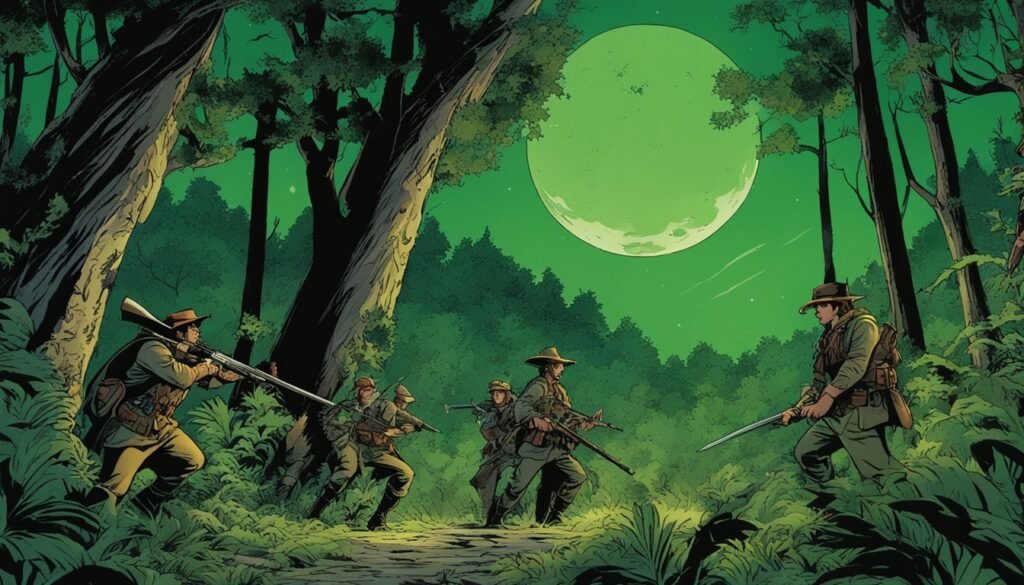In the Philippines, within lush landscapes, stands a key figure from its folklore. This figure is the Pilandok, a crafty and playful trickster chevrotain, or “mouse deer.” Despite its small size, it uses its quick mind and agility to overcome obstacles. The Pilandok has become a beloved part of Philippine culture, admired for its cunning tricks.
Among the Maranao and Maguindanao people, tales of the Pilandok are especially loved. They tell of its adventures, where it challenges power and social rules. Pilandok symbolizes the common people’s spirit, their fight against oppression, and their will to succeed despite hardships.
Key Takeaways
- Pilandok is a beloved character in Philippine folklore, known as the trickster chevrotain or mouse deer.
- In the folktales, Pilandok is portrayed as a clever, mischievous figure who outwits larger and more powerful adversaries.
- Pilandok tales are popular across different regions in the Philippines, particularly among the Maranao and Maguindanao people.
- The Pilandok narratives highlight the character’s ability to challenge authority and social norms. This makes him a representation of the common folk’s resilience and ingenuity.
- The Pilandok stories captivate audiences and continue to be a significant part of Philippine cultural heritage.
Introduction to Pilandok: The Philippine Folklore Hero
Pilandok comes from the Filipino word for the small chevrotain, a deer-like mammal in the Philippines. In Pilandok stories, this character is smart and quick. He uses his mind to solve problems and beat bigger, stronger foes. The Pilandok tales show how the mouse deer is a symbol of thinking and resilience in tough times.
Origins and Etymology of the Word “Pilandok”
The word “Pilandok” comes from the name of the small chevrotain, a deer-like animal from the Philippines. This link between the Pilandok character and the real mouse deer shows deep cultural meanings. It’s a part of the rich Philippine folklore tapestry.
Pilandok as a Representation of the Mouse Deer
In the Pilandok stories, Pilandok’s cleverness mirrors the mouse deer. His small size seems weak against bigger challenges. But, he uses his brains to win, teaching us about overcoming through wit.
The Trickster Archetype in World Folklore
The Pilandok character is a clear example of the trickster archetype in folklore across the globe. Trickster figures are known for being clever, tricky, and always ready to outsmart any problem. They have traits like intelligence, cunning, and creativity. They’re famous for not following typical social rules.
Characteristics of the Trickster Figure
Tricksters are masters of tricks and wit found in world folklore. They are skilled in deceiving others and thinking on their feet. Often, they shake things up by going against rules or authority. They might do this for themselves or to fight for fairness.
These intriguing characters can change their shape or appearance. This ability helps them in their clever plans. They can be animals one minute and a different being the next.
Examples of Trickster Characters from Different Cultures
In different parts of the world, you’ll find various trickster characters in world folklore. For instance, the coyote in Native American stories, the fox in Japanese tales, and the spider in West African stories are well-known. They all bring a new way of thinking. They challenge the big powers, showing the resilience and ingenuity of everyday people.

Pilandok: The Trickster Chevrotain of Philippine Mythology
Pilandok is a key character in the amazing stories of Philippine folklore. He is small but smart, often taking on big challenges. This includes kings, nobles, and even crocodiles and tigers. By being clever, Pilandok beats them at their own game. He highlights their flaws, like greed, self-centeredness, and misuse of power. The stories show how Filipinos remain strong, using their wits to face any troubles, big or small.
“Pilandok, the small and nimble chevrotain, proves that size and strength are no match for a clever mind and a determined heart.”
| Key Characteristics of Pilandok | Significance in Philippine Mythology |
|---|---|
| Clever trickster figure | Represents the resilience and ingenuity of the common folk |
| Small and seemingly insignificant creature | Challenges the authority and power of larger, more formidable characters |
| Outwits adversaries through cunning and resourcefulness | Exposes the greed, selfishness, and abuse of power by those in positions of authority |
The tales of Pilandok reflect the Filipino spirit clearly. They show how people beat challenges using their intelligence. These stories are an essential part of Philippine culture. Pilandok is more than a character; he is a symbol of hope and cleverness in the face of difficulty.
Popular Pilandok Tales and Their Significance
The Pilandok folktales are admired for smart stories and funny endings. Specifically, the tale “Pilandok and the Falling Sky” shows Pilandok tricking his rival into thinking the sky is falling. This makes his rival tie himself to a tree for safety. In the story “Pilandok and the Sumusong sa Alongan,” Pilandok tricks a rich prince. He makes the prince believe a beehive is a royal gong. This allows Pilandok to take the prince’s gold. Then, in “Pilandok in the Kingdom of the Maranaw Sea,” Pilandok bests Datu Usman. Datu Usman wants to kill Pilandok by throwing him into the ocean. These stories highlight Pilandok’s cleverness as he challenges the powerful through his schemes.

The Role of Pilandok in Philippine Folklore
In Philippine folklore, Pilandok is crucial. He stands for the common people and their fight against injustice. Pilandok is a small but smart character. He shows how ordinary people can beat those in power with their intelligence.
Pilandok as a Representation of the Common Folk
Pilandok’s tricks are a type of protest. He helps those at the bottom challenge the powerful. Pilandok’s cunning reveals the bad deeds of leaders. This gives a voice to the common people. It shows the unfairness in Philippine society.
Pilandok’s Tricks as a Form of Resistance
Despite his size, Pilandok symbolizes the strength and creativity of the common people. They find smart ways to tackle the problems caused by the powerful. Pilandok’s clever actions fight against the unfair systems in the Philippines.
Regional Variations of the Pilandok Stories
The Philippines have Pilandok tales in many areas. Each region tells these stories in unique ways, reflecting their cultures. For instance, in Mindanao, the Maranao and Maguindanao people share Pilandok stories that show his cleverness. In their stories, Pilandok takes on those in power, representing the common people.
Tagalog and Visayan Versions of Pilandok
There are also Tagalog and Visayan Pilandok tales. Even though they differ slightly, they all highlight Pilandok’s craftiness. This shows how Pilandok is loved by many Filipinos, despite the variations in stories.
So, Pilandok stories varied across the Philippines. They illustrate the wide range of Filipino folklore. From Maranao and Maguindanao in Mindanao to the Tagalog and Visayan areas elsewhere, Pilandok stories remain popular. They show the wit and courage of the Filipino people.
Pilandok in Philippine Literature and Media
The Pilandok is a well-known character in Philippine literature and media. It highlights the enduring charm and cultural importance of this trickster character. In literary works, Pilandok shows up in folktales. For instance, in Dimalanta’s “Mga Pakikipagsapalaran ni Pilandok: Halaw sa Kuwentong-Bayan ng Maranaw” and Eugenio’s “Philippine Folktales.” These books have made Pilandok stories known to more people.
Pilandok in Films, TV Shows, and Comics
Moreover, the trickster chevrotain stars in Filipino films, television shows, and comic books. This cements its place in Filipino culture. These modern takes have shared Pilandok with new generations. They make sure folklore hero remains loved and relevant.
| Medium | Examples of Pilandok Appearances |
|---|---|
| Literature | “Mga Pakikipagsapalaran ni Pilandok: Halaw sa Kuwentong-Bayan ng Maranaw” by Dimalanta, “Philippine Folktales” by Eugenio |
| Film | TBA |
| TV Shows | TBA |
| Comics | TBA |

The Cultural Significance of Pilandok
The Pilandok is key in Filipino culture, symbolizing resilience, smartness, and victory against odds. Despite being small and weak, Pilandok beats bigger foes, showing the Filipino fighting spirit. This reflects the Filipino people’s will and resourcefulness. Pilandok’s wit is cheered, valuing cleverness in Philippine culture.
Pilandok as a Symbol of Resilience and Wit
Pilandok stories are loved over time and place, showing their timeless value. These tales still engage us, revealing the heart of Filipino tradition and their values. They show resilience, humor, and how regular people win over hardships.
The Enduring Popularity of Pilandok Tales
The Pilandok tales deeply root in Filipino life, filling its people with pride. They reflect Philippine values and bring everyone together, no matter the region or group. Pilandok encourages resilience, humor, and unity against tough times.
Pilandok in Contemporary Philippine Society
In the Philippines today, the Pilandok character is more than just a figure in stories. It’s a metaphor for real-life social and political issues. Pilandok challenges authority and shows the flaws of the powerful.
This symbolizes how regular people fight against corruption, social inequality, and abuse of power. Pilandok’s tales are now seen in a new light. They’re used to talk about today’s problems and give a voice to the sidelined.
Efforts are made to keep the traditional Pilandok folktales alive. Many organizations, scholars, and community groups work together on this. They collect, document, and pass on these stories. They share how Pilandok shows the Filipino spirit of cleverness and strength.

The Animal World of Philippine Mythology
The Pilandok represents the small and seemingly insignificant chevrotain. It’s not the only notable animal character in Philippine mythology. The Filipino folklore is full of diverse and vibrant animal characters. They each have unique symbolism and cultural importance.
The crocodile is often seen as powerful and dangerous. On the other hand, the monkey can be a mischievous trickster, much like the Pilandok. These animals are more than physical beings. They stand for different human traits and social dynamics.
This shows how deeply connected nature and belief are for the Filipino people. The animal world of Philippine mythology is rich and deep. It sheds light on the cultural and symbolic meaning of these creatures within the folktales and legends.
The Influence of Pilandok on Philippine Identity
The Pilandok character and its stories have shaped the Philippine identity greatly. It represents the resilience and cleverness of ordinary Filipinos. These traits have helped them stand up to authority. They also echo the long fight for freedom against colonizers.
Pilandok tales are now a key part of Filipino culture. They make Filipinos proud and show what’s important in their national identity. These stories are popular all over the Philippines. They bring people together with their messages of staying strong, finding humor, and beating hard times together.
Pilandok: A Celebration of Filipino Ingenuity
The Pilandok folktales cheer on Filipino ingenuity and how the underdog can win against all odds. They show us that even when faced with tough challenges, quick thinking and creativity can lead to success. These stories are a rich part of Philippine culture, showing the spirit, smart solutions, and strength of its people. They demonstrate how Filipinos tackle problems with a smile, always fighting to make their mark and stand up against unfairness.
The Pilandok character is adored for being smart, creative, and standing up for what’s right, becoming a symbol of resilience. As people continue to enjoy the Pilandok tales, they celebrate the never-give-up attitude and smart solutions that are central to the Filipino people’s character.

Conclusion
The Pilandok from Philippine folklore is quite a character. He’s known for his cleverness and tricks. As a symbol of the common people’s spirit and their fight against injustice, Pilandok is dearly loved. He stands for adaptability and wit, inspiring many with his stories. These tales have changed over time but still show the strength of the Filipino community and their shared beliefs.
Celebrating the Pilandok narrative keeps its stories alive. In these stories, Pilandok embodies the victory of the underdog. His stories remain popular all over the Philippines, resonating deeply with the people. They are tales of common folk facing and overcoming challenges through cleverness and determination.
Today, Pilandok is a light in uncertain times. His stories remind the Filipino people of their strength in difficult situations. By continuing to tell his stories, the Philippines honors its resilient spirit. This way, the legacy of Pilandok always serves as an inspiration for all.

